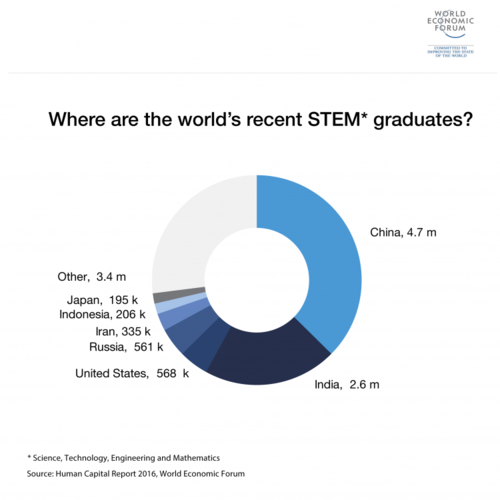Thành viên:Nguyenthephuc/Note: Ways to prepare kids for jobs of future
The world’s education systems are failing our children by not preparing them for the workplace of the future. This is the key finding of a new report by the World Economic Forum, Realizing Human Potential in the Fourth Industrial Revolution, which puts forward a series of practical measures for aligning education and training with future job requirements.
Mục lục
Training for jobs that don’t yet exist[sửa]
Technology and globalization continue to reshape business models across all sectors and geographies, creating new types of jobs and disposing of old ones at great pace. However, monolithic, underfunded education and training systems around the world have fallen short of responding to this trend. This means that by the time they leave education, as many as two-thirds of children entering primary school today will not have the skills required to get a job. The impact will be worse for women who already have less than two-thirds of the economic opportunity that men have.
The report was put together by a panel of business leaders, policy-makers, unions, educational institutions and academics. It recommends that governments and the private sector work together in eight core areas to ensure the world’s children are equipped for the future.
Reinventing education for a new age[sửa]
1. Focus on the early years[sửa]
Reinventing education starts in early childhood, where the focus should be on literacy and reading. Adequate childcare provision for working parents will be critical in both developed and developing economies.
2. Keeping it dynamic[sửa]
Training curricula must be aligned with market demand for skills – both job-specific and generic, such as problem-solving and project management. The challenge will be to keep these curricula dynamic and responsive to evolving business needs. In Finland, one of the world’s top-performing nations in education, the curriculum is updated regularly to provide an overall framework, with room for local adaptation by the schools themselves.
3. Open-sourcing education[sửa]
The report advocates adopting training innovations more quickly, opening up to alternative learning routes (such as Hackathons) and allowing for experimentation with new techniques. For example, the New York City Department of Education has created "Lab" schools and tasked them with reinventing teaching and learning. In Ghana, the US and France, schools are pioneering short courses in coding based on peer-to-peer teaching, project-based learning and gamification.
4. Taking teachers out of the ivory tower[sửa]
To bring education and business closer together, the report recommends initiatives such as teacher "externships" in businesses, workplace mentoring and involving the private sector in teacher training.
5. Giving students a sense of the real world of work[sửa]
Similarly, students should experience the world of work from early on – for example through internships and ongoing career coaching – to help them see a variety of career options and the skills required.
6. Addressing the vocational stigma[sửa]
Vocational and technical education is critical to the world economy but has been neglected and often looked down on as second best. The World Economic Forum advocates promoting vocational and technical career paths more proactively and raising the quality of vocational training on offer. For example, Germany’s vocational training system sees apprentices divide their days between classroom instruction and on-the-job training at a company. Apprentices are paid and their training typically extends to between two and three years. Not only does this approach create an excellent talent pool, it also smooths the – often difficult – transition from education to the world of work.
7. Digital fluency[sửa]
Digital skills will be fundamental to a wide range of careers, but "digital fluency" is not a given. The report highlights the need for a greater focus on ICT in teacher training and students’ work placements to address the growing digital skills crisis. One successful example comes from India, where the National Association of Software and Services Companies (NASSCOM) has partnered with NGOs and the Government of India to build National Digital Literacy Centres across the country to enable digital literacy.
8. Education, education, education[sửa]
Given the rapid evolution of the job market, workers can no longer rely on just one skillset or narrow expertise to sustain long-term careers. The report advocates incentivizing employees to commit to lifelong learning so they continue to develop their skills or even retrain for new roles. For example, in Singapore, individuals receive an annual training allowance they can spend on a range of training courses all geared towards developing future-oriented skills.
The fourth industrial revolution will turn the world of work as we know it on its head as it continues to unfold. The report suggests that, unless the world’s monolithic education systems can be reformed and rendered more nimble, their failings will come back to haunt future generations’ ability to prosper.
Bản dịch[sửa]
Bản dịch dưới đây của Đàm Quang Minh
1. Tập trung vào những năm đầu đời[sửa]
Giáo dục mới tập trung vào những năm đầu đời tập trung vào các kỹ năng ngôn ngữ và đọc. Sự quan tâm thích đáng chăm sóc trẻ em cho các phụ huynh đang làm việc sẽ là mốc quan trọng cho cả các quốc gia phát triển hay đang phát triển.
2. Duy trì sự năng động[sửa]
Chương trình đào tạo cần phải bám sát với nhu cầu thị trường cho cả các kỹ năng cơ bản và kỹ năng chuyên biệt, ví dụ như giải quyết vấn đề hay quản trị dự án. Thách thức của việc duy trì sự năng động của chương trình và đáp ứng được sự phát triển của kinh doanh. Ở Phần Lan, một trong những quốc gia có chất lượng giáo dục cao nhất, chương trình học được cập nhật thường xuyên dựa trên khung chuẩn cho phép các trường được địa phương hóa về nội dung.
3. Giáo dục nguồn mở[sửa]
Các báo cáo phản biện chấp nhận sáng tạo trong đào tạo ngày càng nhanh, mở ra những phương thức học tập khác (ví dụ Hackathons) và cho phép trải nghiệm những công nghệ mới. Ví dụ, Sở giáo dục Tp. New York đã tạo ra trường học “Thí nghiệm” nhằm sáng tạo về dạy và học. Tại Ghana, Mỹ và Pháp, trường học đang tiên phong trong việc dạy những khóa ngắn về lập trình dựa trên dạy một – một, học theo dự án (project based learning) hoặc học mô phỏng game (gamification).
4. Kéo giáo viên khỏi tháp ngà[sửa]
Đưa học tập và kinh doanh lại gần với nhau, báo cáo chỉ ra sáng kiến đưa giáo viên “chuyên gia ngoài” từ doanh nghiệp, hướng dẫn và tham gia vào các chương trình đào tại giảng viên.
5. Giúp sinh viên cảm nhận được thực tế công việc[sửa]
Tương tự như vậy, sinh viên cần được trải nghiệm về cuộc sống công việc sớm. Ví dụ thông qua các chương trình thực tập hoặc tham gia định hướng nghề nghiệp nhằm giúp sinh viên cái nhìn đa diện về cơ hội nghề nghiệp và các kỹ năng cần thiết.
6. Định vị dấu ấn về dạy nghề[sửa]
Dạy nghề và đào tạo kỹ thuật là điểm mấu chố của nền kinh tế toàn cầu nhưng đã bị sao nhãng và coi thường như hạng hai. Diễn đàn kinh tế thế giới đề xuất tăng cường hướng nghiệp dạy nghề và kỹ thuật một cách chủ động và nâng cao chất lượng dạy nghề. Ví dụ, hệ thống đào tạo nghề của CHLB Đức định hướng người học chia thời gian giữa học trong lớp và học tập tại doanh nghiệp. Người học được trả tiền và quá trình học có thể kéo dài thêm 2-3 năm. Không những mô hình này hữu dụng mà còn tạo một nguồn tài năng trong công việc, dịch chuyển từ giáo dục sang nghề nghiệp.
7. Ảnh hưởng số[sửa]
Kỹ năng số sẽ là thiết yếu cho rất nhiều nghề nghiệp nhưng ảnh hưởng số vẫn chưa hiện thực. Báo cáo chỉ ra sự cần thiết của việc tập trung cao vào CNTT trong việc đào tạo giáo viên và hướng nghiệp sinh viên vào những kỹ năng số. Một ví dụ thành công tại Ấn độ, Hiệp hội các công ty phần mềm và dịch vụ quốc gia đã liên kết với các tổ chức phi chính phủ và Chính phủ Ấn Đô thành lập Trung tâm phổ cập số quốc gia trên khắp quốc gia để phổ cập kỹ năng số.
8. Học, Học và Học[sửa]
Với sự phát triển nhanh chóng của thị trường việc làm, người lao động hiện nay không còn chỉ dựa vào một kỹ năng và năng lực chuyên môn hẹp trong thời gian dài của sự nghiệp. Báo cáo chỉ ra răng nhân sự có cam kết về học tập suốt đười sẽ tiếp tục phát triển tiếp các kỹ năng hoặc tự đào tạo lại để nắm những nhiệm vụ mới. Ví dụ tại Singapore, cá nhân có thể nhận trợ cấp đào tạo hàng năm để tham gia các khóa học hướng tới phát triển các kỹ năng cần thiết trong tương lai.
Nguồn[sửa]
Các ghi chú của cùng tác giả
- So sánh điểm kì thi tốt nghiệp trung học của Hà Giang và cả nước
- Học làm cha, làm mẹ
- Đọc sách 2 giờ mỗi ngày (Từ 4-6h sáng)
- Rễ, thân cành, và lá
- Sự trở lại của các thành bang
- Việt Nam học được gì từ bài học Phần Lan trong đổi mới giáo dục
- Đằng sau sự thành công của giáo dục Phần Lan là gì?
- Bí mật trong tuyển chọn và đào tạo giáo viên Phần Lan
- Chiến tranh và khó khăn - lý do khiến giáo dục Việt Nam khó phát triển
- Năng lực và các khái niệm liên quan







